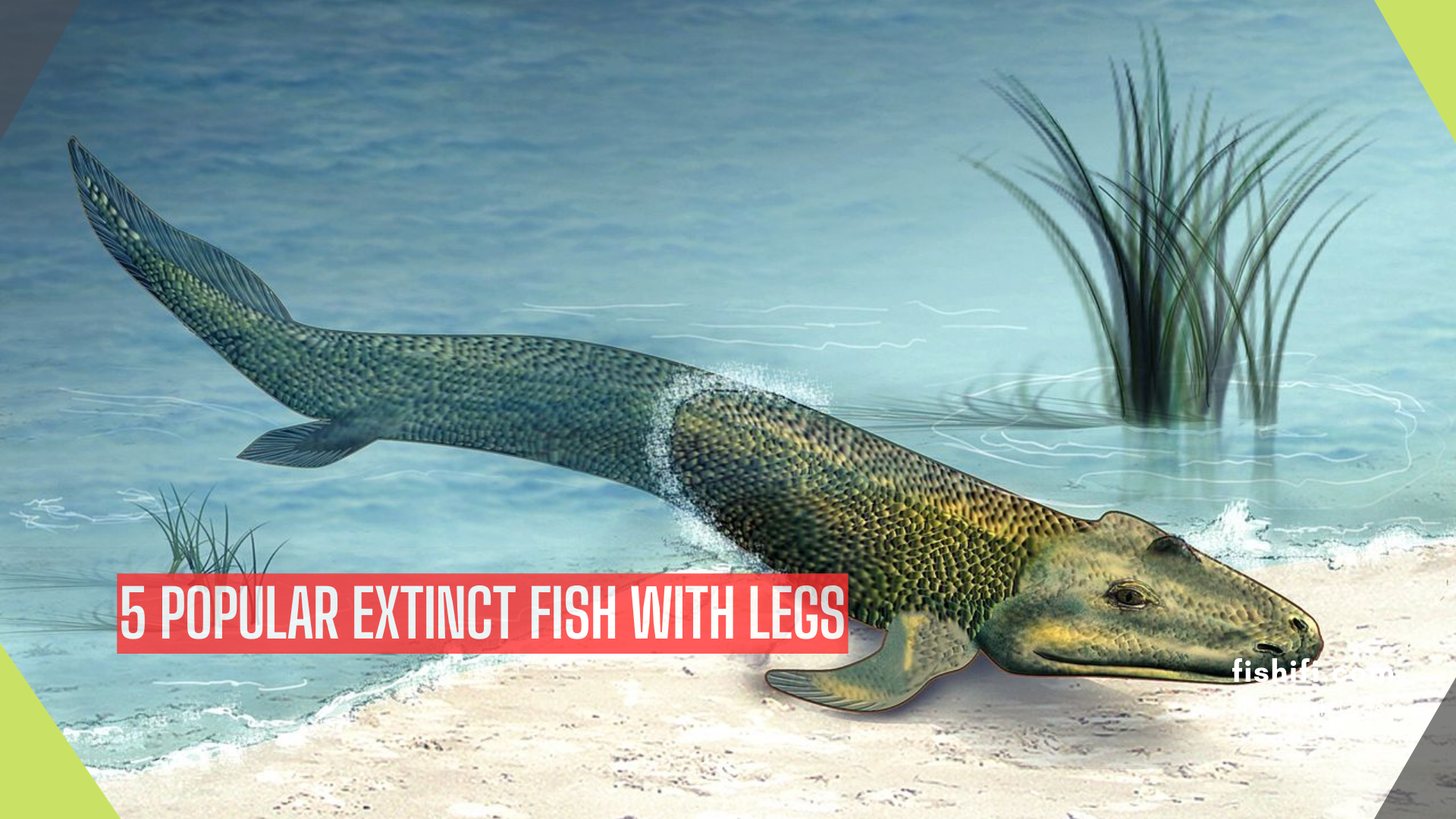Here’s a cool list of more than 5 popular extinct fish with legs or other special parts to help them walk underwater. So let’s dive in and learn about these awesome walking fish!
1 Tiktaalik
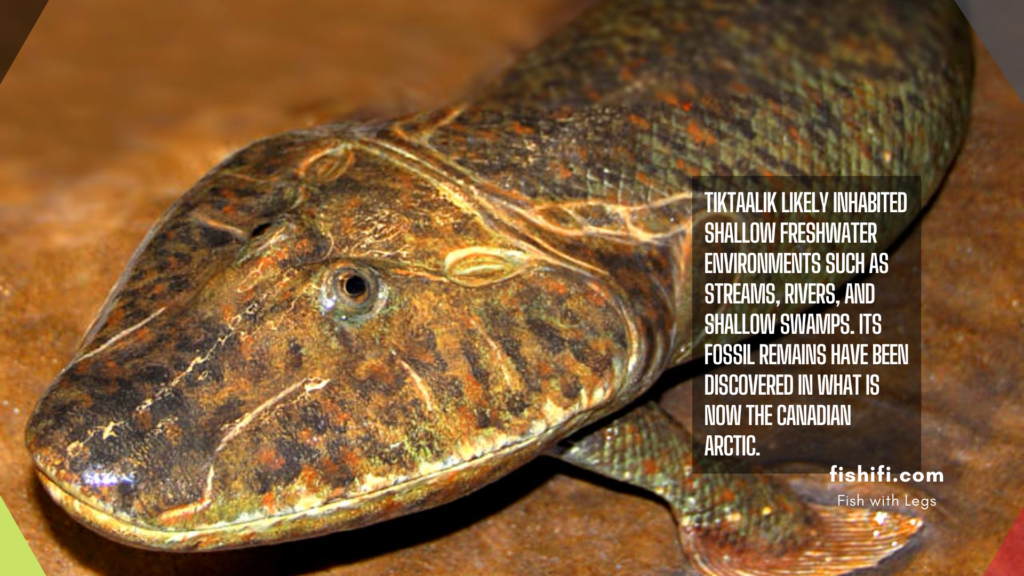
Table of Contents
Scientific Name: Tiktaalik roseae
Tiktaalik is an ancient fish species that lived approximately 375 million years ago during the Late Devonian period. It is an essential transitional species in the evolutionary lineage from fish to tetrapods (four-legged animals).
Here are some key details about Tiktaalik:
Size and Appearance: Tiktaalik had a length of about 2 to 3 meters (6.5 to 10 feet) and a long, flat head. Its body structure was fish-like, but it also possessed several features that bridged the gap between fish and land-dwelling animals.
Limb-like Appendages: One of the most notable features of Tiktaalik is its limb-like appendages, which had a series of robust bones similar to those found in tetrapods. These limb structures had a functional elbow joint and could potentially support Tiktaalik’s weight while navigating shallow waters or muddy environments.
Habitat: Tiktaalik likely inhabited shallow freshwater environments such as streams, rivers, and shallow swamps. Its fossil remains have been discovered in what is now the Canadian Arctic.
Diet: Based on its skull and tooth structure, it is believed that Tiktaalik was a predator. It likely fed on a variety of aquatic organisms such as smaller fish, invertebrates, and possibly even small amphibians.
Tiktaalik is of significant interest to scientists as it represents an important transitional species, showcasing the adaptations that occurred during the transition from fish to early tetrapods. Its discovery provides valuable insights into the evolutionary history of vertebrates and the colonization of land by vertebrate animals.
Acanthostega
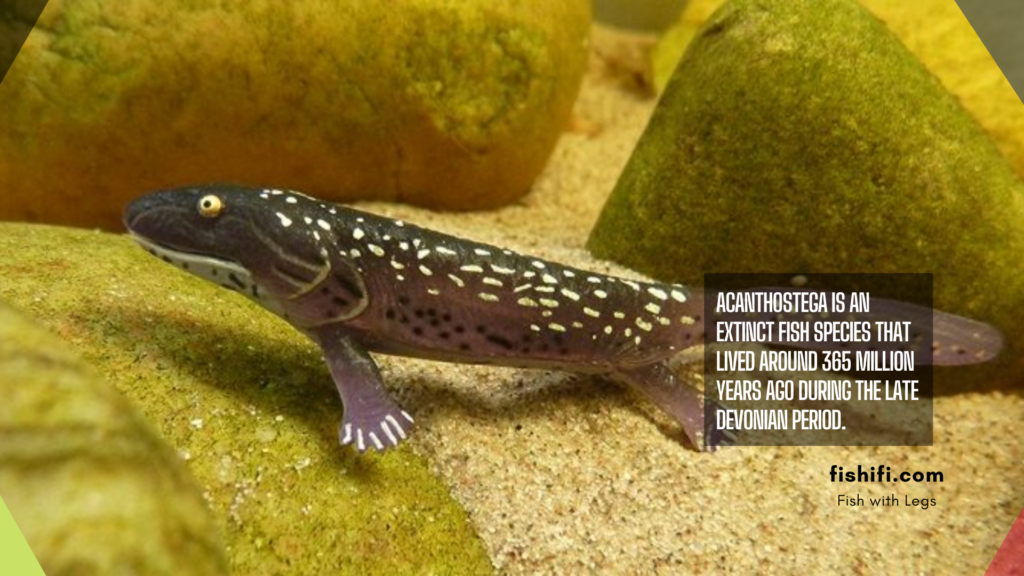
Scientific Name: Acanthostega gunnari
Acanthostega is an extinct fish species that lived around 365 million years ago during the Late Devonian period. It represents an important transitional form in the evolution from fish to tetrapods (four-legged vertebrates). Let’s explore more about Acanthostega.
Diet: Acanthostega was likely a carnivorous predator. Its diet probably consisted of small aquatic invertebrates, such as worms, small crustaceans, and other small fish.
Anatomy and Physiology:
- Limbs: Acanthostega had limbs with well-developed bones, similar to the limbs of tetrapods. These limbs were positioned underneath its body, which suggests that it had the ability to prop itself up and potentially support its weight. However, its limbs were still primarily adapted for aquatic locomotion rather than walking on land.
- Fingers and Toes: Acanthostega had multiple digits on its limbs, with eight fingers and seven toes. This was a significant characteristic as it indicated an early stage of limb development and the presence of digits that would later become more specialized in tetrapods.
- Gills and Lungs: Acanthostega had both gills and lungs, suggesting it had the ability to respire using both underwater and air-breathing methods. This adaptation likely allowed it to survive in oxygen-depleted water or stagnant environments. However, its gills were better developed than its lungs, indicating a stronger reliance on underwater respiration.
- Tail and Fins: Acanthostega had a fish-like tail and fins, indicating that it was still primarily adapted for swimming. The presence of limbs with digits did not completely replace its aquatic locomotion abilities.
- Skull and Teeth: Acanthostega had a flat skull with eyes positioned on top. Its jaws were equipped with sharp teeth, indicating its predatory nature and the ability to catch and consume small prey.
Internal Structure: Acanthostega had a well-developed ribcage and a vertebral column, suggesting a degree of stability in its body structure. This likely helped it support its weight in water or when propelling itself through shallow environments.
Habitat: Acanthostega likely inhabited shallow, freshwater environments such as swamps, lakes, and slow-moving streams. Its ability to breathe both underwater and in the air may have allowed it to venture into oxygen-depleted or stagnant waters.
Acanthostega holds a significant place in the study of vertebrate evolution, as it provides valuable evidence of the transitional forms that existed during the shift from aquatic life to land-dwelling vertebrates. Its fossils have provided scientists with crucial information about the anatomical changes that occurred during this pivotal period in Earth’s history.
Ichthyostega
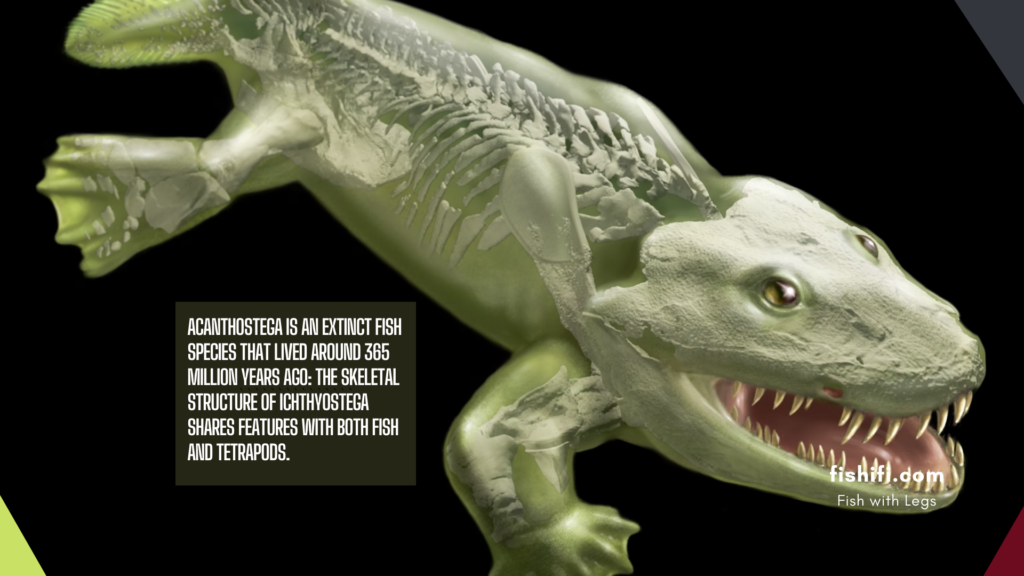
Ichthyostega is not actually a fish, but rather an extinct genus of tetrapodomorph vertebrates that lived during the Late Devonian period, approximately 358 to 359 million years ago. It is considered one of the earliest tetrapods, representing a crucial transition from fish to land-dwelling animals. Here is some detailed information about Ichthyostega:
Scientific Name: Ichthyostega (meaning “fish roof” or “fish-covered”)
Diet: Ichthyostega was likely a carnivorous animal. Its diet mainly consisted of small aquatic invertebrates, such as fish, crustaceans, and various insects that inhabited the freshwater ecosystems where it lived.
Anatomy and Physiology:
- Size and Appearance: Ichthyostega was relatively large for its time, with an estimated length of up to 1.5 meters (4.9 feet). It had a heavyset body and a broad skull, resembling a combination of fish and amphibians. Its limbs were robust and supported by strong bones, indicating adaptations for supporting its weight on land.
- Skeleton: The skeletal structure of Ichthyostega shares features with both fish and tetrapods. Its vertebral column was elongated and flexible, allowing for a range of movements. The limbs were composed of strong bones and had well-developed joints, suggesting that Ichthyostega was capable of bearing weight on land.
- Locomotion: The limbs of Ichthyostega were well-suited for both swimming and terrestrial locomotion. However, based on the structure of its limbs and its overall anatomy, it is believed that Ichthyostega would have been more proficient in water than on land. It likely used a combination of lateral undulation and limb movements to propel itself through the water.
- Lungs: One of the most important adaptations of Ichthyostega was the presence of lungs, indicating its ability to breathe air. Although it still relied on gills for respiration in water, the presence of lungs suggests that Ichthyostega could venture onto land for short periods, allowing it to exploit terrestrial food resources and potentially escape unfavorable aquatic conditions.
- Polydactyl Limbs: Ichthyostega had limbs with more than the typical number of digits found in most tetrapods. It had seven or eight digits on its forelimbs and six or seven digits on its hindlimbs. This feature is considered an example of evolutionary experimentation during the transition from fish to land-dwelling animals.
Other Information
Habitat: Ichthyostega inhabited shallow freshwater environments, such as swamps and shallow rivers. It likely lived in areas with abundant vegetation and relatively warm temperatures, providing a suitable habitat for the species.
Paleontological Significance: Ichthyostega is a crucial fossil in understanding the transition of vertebrates from aquatic to terrestrial life. Its discovery has provided valuable insights into the evolution of limbs, lungs, and other adaptations necessary for life on land.
Extinction: Ichthyostega and other related species became extinct by the end of the Devonian period. The exact reasons for their extinction are not well understood, but it is likely that changes in environmental conditions and competition with more adapted terrestrial animals played a role.
Fossil Discoveries: Fossils of Ichthyostega have been found in Greenland, where they were first discovered in the early 20th century. The remains of several individuals, including both juveniles and adults, have been unearthed, providing scientists with a wealth of information about their anatomy and biology
Eusthenopteron
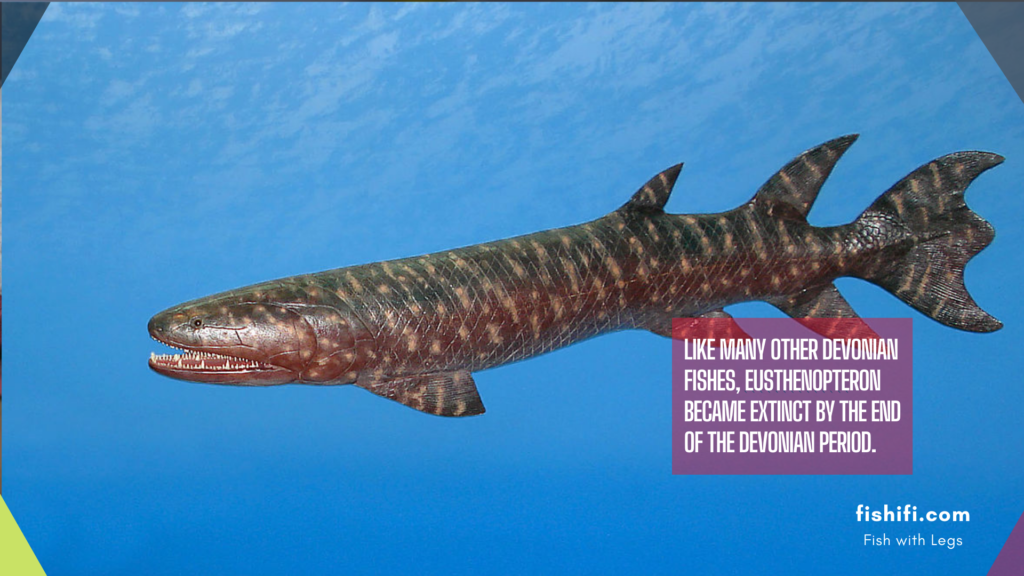
Scientific Name: Eusthenopteron
Diet: Eusthenopteron was a carnivorous fish, primarily feeding on small aquatic invertebrates and fish. Its diet likely consisted of prey such as crustaceans, insects, and smaller fish.
Anatomy and Physiology
- Size and Appearance: Eusthenopteron was a relatively large fish for its time, with adult individuals reaching lengths of approximately 1.5 meters (5 feet). It had a streamlined body shape with a long snout and a large mouth, equipped with sharp teeth for capturing and consuming its prey.
- Fins: Eusthenopteron possessed well-developed fins, including pectoral fins (located on the sides of the body), pelvic fins (located closer to the rear), and a well-defined dorsal fin running along its back. These fins provided stability and control during swimming, enabling Eusthenopteron to maneuver in the water.
- Lobe-Finned Fish: Eusthenopteron belongs to a group of fishes known as lobe-finned fish, characterized by their fleshy lobed fins. These lobes contained skeletal elements similar to those found in the limbs of early tetrapods, making them significant in the evolutionary transition from fish to land-dwelling animals.
- Lungs and Gills: Eusthenopteron possessed both lungs and gills, indicating it had the ability to breathe both air and water. While gills allowed respiration in aquatic environments, the presence of lungs suggests that Eusthenopteron could also extract oxygen from air, allowing it to tolerate oxygen-poor or stagnant waters.
- Locomotion: Eusthenopteron likely used its well-developed fins for swimming. Its strong caudal fin provided propulsion, while the pectoral and pelvic fins aided in steering and maneuverability. The lobed structure of its fins suggests that Eusthenopteron could use them to support its body weight and possibly navigate shallow waters or even briefly move across land.
Other Information
Habitat: Eusthenopteron inhabited shallow marine environments during the Late Devonian period, approximately 385 to 359 million years ago. Fossil evidence suggests that it lived in nearshore regions, such as coastal lagoons and estuaries.
Paleontological Significance: Eusthenopteron is a crucial fossil in understanding the evolutionary history of tetrapods. Its skeletal features, particularly its lobe fins, bear striking similarities to the limbs of early tetrapods. This has led scientists to propose that Eusthenopteron and related lobe-finned fishes are ancestral to land-dwelling vertebrates.
Fossil Discoveries: Fossils of Eusthenopteron have been found in several locations, including Canada (Quebec), Greenland, and Latvia. These fossils provide important insights into the anatomy, lifestyle, and evolutionary adaptations of this ancient fish.
Transitional Characteristics: Eusthenopteron exhibits several features that are considered transitional between fish and tetrapods. Its lobed fins are seen as precursors to the limbs of terrestrial vertebrates, showcasing the gradual evolution of limbs from fins. The presence of lungs and well-developed gills also indicates adaptations for a dual aquatic and aerial respiratory system.
Extinction: Like many other Devonian fishes, Eusthenopteron became extinct by the end of the Devonian period. The exact reasons for its extinction are not known, but changing environmental conditions and competition with other species likely played a role.
Panderichthys Rhombolepis
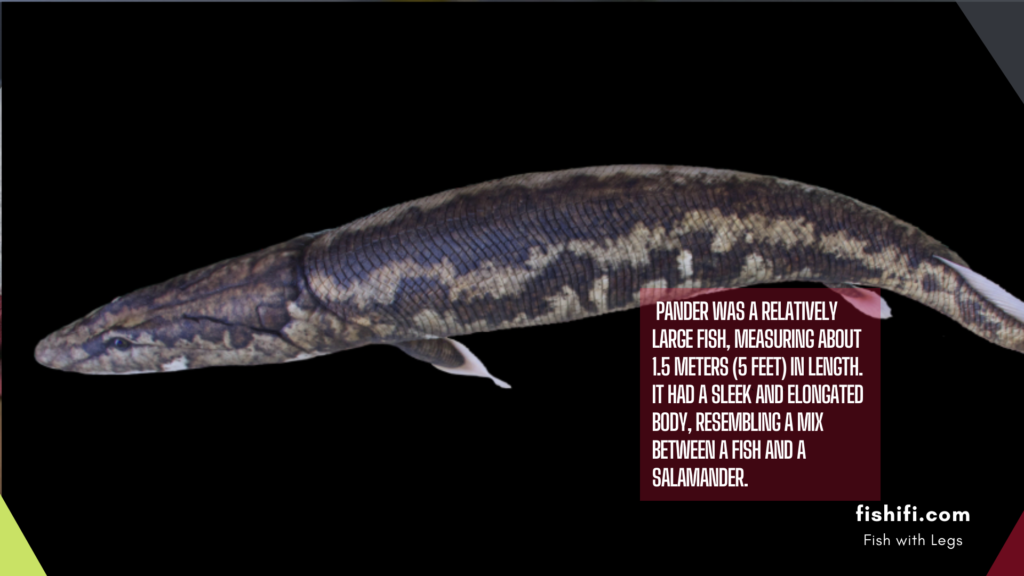
Let’s explore Panderichthys Rhombolepis, or Pander, in detail
Scientific Name: Panderichthys Rhombolepis
Diet: Pander was a carnivorous fish, meaning it had a taste for meat. Its diet consisted of various aquatic creatures. Pander would hunt and devour small fish, insects, and even crustaceans. It was a skilled predator, always on the prowl for its next meal.
Anatomy and Physiology
Pander had a remarkable anatomy and physiology, showcasing its unique characteristics.
- Size and Shape: Pander was a relatively large fish, measuring about 1.5 meters (5 feet) in length. It had a sleek and elongated body, resembling a mix between a fish and a salamander.
- Fins: Pander’s fins were one of its distinguishing features. Its pectoral and pelvic fins were robust and well-developed, almost resembling limbs. These limb-like fins contained bones similar to those found in the limbs of early land-dwelling animals, suggesting Pander’s evolutionary path towards terrestrial life.
- Dorsal Fin: Pander had a prominent dorsal fin running along its back. This fin provided stability and control while swimming through the water, aiding in maneuverability.
- Breathing Adaptations: Pander had a fascinating respiratory system. It possessed both gills and lungs, enabling it to breathe in different environments. While gills allowed respiration in water, Pander also had lungs to extract oxygen from the air. This adaptation suggests that Pander could survive in low-oxygen or stagnant waters and potentially venture onto land for short periods.
- Skeletal Features: Pander’s skeletal structure provided important insights into its transitional nature. The bones in its fins exhibited similarities to the limb bones of tetrapods, hinting at the evolutionary link between fish and land-dwelling animals.
Other Information
- Pander lived during the Late Devonian period, approximately 385 to 359 million years ago. It inhabited shallow marine environments, favoring coastal areas such as lagoons and estuaries.
- In the evolutionary context, Pander is a crucial species. It represents a significant transitional form between fish and tetrapods (four-limbed vertebrates). Pander’s limb-like fins and the presence of lungs demonstrate adaptations that foreshadowed the eventual movement of vertebrates from water to land.
- Fossils of Panderichthys Rhombolepis have been found in various locations, including Estonia and Latvia. These fossils have provided valuable information about the anatomy, lifestyle, and evolutionary significance of this remarkable fish.
- Pander, with its unique combination of fish-like and tetrapod-like traits, illustrates the fascinating story of life’s journey from water to land. Its existence bridges the gap between two distinct habitats, showcasing the remarkable adaptability and innovation of ancient organisms.

